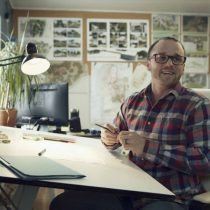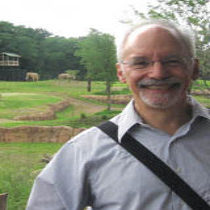Landscape Architecture for Landscape Architects › Forums › GENERAL DISCUSSION › Designing Natural Play Spaces for Children
- This topic has 1 reply, 13 voices, and was last updated 10 years, 9 months ago by
 Trace One.
Trace One.
-
AuthorPosts
-
March 13, 2013 at 3:22 pm #155390
 Jeffrey LindstromParticipant
Jeffrey LindstromParticipantHey all,
Over the past couple of years there has been a rise in the discussion of the importance of incorporating more nature based-play in children’s environments. Its hard to have a conversation on this topic without mentioning Richard Louv’s “Last Child in the Woods” which seems to have started a widespread, much-needed call to action. As these conversations continue, we are starting to learn more and more about the importance of establishing a meaningful connection to the natural world at an early age, and what we can do to facilitate that relationship as designers.
My question for you all is this; What are some of the most successful spaces, in your eyes, that are successfully connecting children to the natural world? Additionally, what is it about those spaces that make them successful and engaging? As with any “niche” of design, there are many different approaches that people are taking to outdoor classrooms, nature-based play, and establishing a connection to the natural world.
March 14, 2013 at 1:31 pm #155418 Trace OneParticipant
Trace OneParticipantInteresting question. It seems to me that the best types of places to connect kids to nature would be non-programmatic (“Passive recreation”) natural areas. Prospect Park in Brooklyn is one of my favorite designs, I used to do childrens classes on urban nature there, and all you need are trees and grass, a water body is nice also, to get the lessons going.
But just let the kids have open time in natural spaces. I spent many hours with my nieces investigating meadow -grasses from two inches away, finding the bugs, worms, etc. That is enough.
I am also reminded of Isabella Rosellinis really weird videos on bugs and animals, where she is fully costumed and playing the part of a wasp, or something.
So I geuss another concept, pretty cliche really, would be to creat huge play-things of natural organisms – giant dinosaur eggs the kids can play in, etc. ..And there is nothing wrong with a good playground merry-go-round to keep the interest up and the blood flowing..
what do YOU think?
March 14, 2013 at 9:44 pm #155417 Jeffrey LindstromParticipant
Jeffrey LindstromParticipantThanks for the response!
I totally agree with you on the idea that no designed space can really substitute for a truly natural space, and the best places to connect children may not be programmed for activity at all. However, one of the things that we are starting to see is that many of our young parents (my generation) who were themselves disconnected from nature are now raising children. I do believe that the 80’s were when this disconnection from nature started to happen, and many, not all, children started to gravitate towards the outlets and away from outside.
That being said, we are finding it more of a challenge to get young families outside together and really exploring the natural world. How are parents supposed to understand the importance of letting their children explore outside if they themselves never recognized the value of a connection to nature? More importantly, how can we communicate the importance of taking care of our earth and environment if our children have no connection to it, resulting in total apathy. Unfortunately, it seems that when we tell these parents to take their kids outside, they really don’t know where to begin.
Therefore, I think we are seeing a new demand for “transition spaces”. Those that give parents and children an opportunity to slowly immerse themselves in environments that encourage a connection to more natural settings and materials without throwing them out into the woods in a space that is totally unfamiliar and, frankly, uncomfortable. Maybe a contained natural setting that gives parents the piece of mind to let their children explore freely. At the same time finding a way to incorporate a sense of wonder that captivates children by exposing them to the magic of nature – the colors and scents of plants in bloom, caterpillars turning into butterflies, the variety of microorganisms in the soil, etc. After all, weren’t these the life-changing experiences that brought so many of us to this profession of being stewards of the land?
So as designers, how do we create these spaces? I am a big advocate for utilizing natural materials as “loose parts”, a plethora of plant material, open green space, and some unkept areas that aren’t maintained and allowed to be wild. Do children need manufactured play equipment to play, or has that just become a standard that we accepted a long time ago? After all, most equipment tells children where to jump, where to swing, where to climb. How stimulating can these spaces really be? Not to dog on MPE, because I do think there are some great companies who are building some great things and putting a great deal of credible research behind their products, but I do not think equipment can give our children all they need in an effective play environment
Phew, lots of bases to cover and topics that could be elaborated upon much further, but I think that gives the gist of what I am trying to say. To answer your question, some of the projects that come to mind that I am particularly keen of are:
Memphis Botanical Garden: http://www.memphisbotanicgarden.com/mybigbackyard
Hidden Hollow @ Heritage Museum & Garden: http://heritagemuseumsandgardens.org/hidden-hollow-2/
Tree Adventure @ Arbor Day Farm: http://www.arbordayfarm.org/index.cfm
Check them out and let me know what you think!
March 15, 2013 at 7:09 am #155416 CoordinatesParticipant
CoordinatesParticipantDesigning natural play spaces for kids is a great idea indeed, and it is very essential for creating that much needed bonding between nature and mankind right from the childhood. We need to save nature to save ourselves in the future.
March 15, 2013 at 2:41 pm #155415 Trace OneParticipant
Trace OneParticipantWow..Memphis botanical is pretty amazing. I just can’t relate – I am not of that generation, I grew up running wild on the streets of Beirut in the sixties, and plus I don’t have kids. But it seems so programmatic, all of it..
Can we outfit each child with a dog to show them how to inspect a natural area? Or just give them a bunch of balls, to set them off through the landscape, like Mary Poppins leading the banks kids into the park by throwing a snowball, and chasing it down……sort of like frisbee golf..?
Are you famililar with Prospect Park or Central Park? Totallly designed, and totally natural, for the most part..
and PS, it is nice to see someone who likes EA Bye – I love his stuff..He was one of my professors..(And he hired me, right out of school..but I turned him down..).Anyway, good topic, perhaps others will choose to express their thoughts..
March 15, 2013 at 3:54 pm #155414 Jeffrey LindstromParticipant
Jeffrey LindstromParticipantWow! Bye is one of those designers that I really wish people knew more about. And so appropriate for this conversation as well. Talk about a guy who really understands the value of wild and natural spaces. I always loved how his goal was to make a space seem as if it wasn’t designed at all and views the L.A.’s role as more of a behind the scenes facilitator between nature and people.
Going off of that idea, that is more of what I was talking about when I mentioned spaces that are designed. Perhaps I should have used the term “over-designed”. Central Park and Prospect Park are perfect examples of what we need more of – natural spaces that just seem like they belong.
So I guess this conversation shifted a little bit from what I originally intended. I was initially thinking more about alternatives to traditional playgrounds that we see in schools, child care facilities, and parks which is why I referred to those projects. I think that intentional programming can be of great value when we think about the cognitive development of children and “whole-child development” in these spaces, especially as we present the argument that the outdoors are the best classrooms, and at the very least, an extension of the classroom.
I agree 100% with you, there is no place as rich as wild space and I wish we could just let children go. I too grew up exploring everything myself… outside all the time for every minute my parents would allow. I was usually up in a tree, down in a creek, or riding my bike everywhere I could. While I absolutely love my job and what I do, it would be great if we didn’t have to exist and these conversations didn’t have to happen – if every child still had that natural desire to just explore. Unfortunately, there is a huge disconnect now and Landscape Architects seems to be the most suited to take on the challenge to reestablish that relationship
This conversation reminds me of a quote I heard a while back:
“Every kid starts out as a natural-born scientist, and then we beat it out of them. A few trickle through the system with their wonder and enthusiasm for science intact.” —Carl Sagan
Actual scientists? Maybe not. But I do think that we stop encouraging them to explore, wonder, and connect to nature…
March 15, 2013 at 3:56 pm #155413 Jeffrey LindstromParticipant
Jeffrey LindstromParticipantCouldn’t agree more!
March 16, 2013 at 10:26 am #155412 John ClarkParticipant
John ClarkParticipantThere is no doubt that games activities lead positive effect on kids growth which make him stronger from both side inner and outer. You said that we as designer need to build places where kids spend their spare times in any healthy activities.
March 17, 2013 at 10:26 am #155411 Leslie B WagleParticipant
Leslie B WagleParticipantNC State U has done a lot of work on this under a special initiative.
One of their pages: http://naturalearning.org/content/projects
March 17, 2013 at 1:13 pm #155410 Trace OneParticipant
Trace OneParticipantLeslie, thank you for that post, what an incredibly rich site. Lots to absorb, thank you so much.
I will never forget the children confined to their buses, until the school bell rang, parked by a nice set of playgrounds, but not allowed to get out before class, even while most of them were on the buses for over an hour. For me, that time playing outside before class was the best part of the day, just about..
But here’s a question. More structured design, more need for guides or care takers for the park. Prospect Park does not need any guides for children to enjoy on their own, totally.Part of the fun part of playing outdoor is the journey to something new..Anyway, what I am saying is if Olmsted could pull off Prospect Park in the middle of Brooklyn a design that is still intact after 100 years, wy do we feel the need to continue to make such programmatic spaces? I am going to come out as a cantankerous proponent for the totally natural, and the totally unstructured..
But I am also going to read that entire site..UNC. Very cool!
March 18, 2013 at 2:16 pm #155409 Leslie B WagleParticipant
Leslie B WagleParticipantYes, I agree that “free range” children would be the ideal, like how my husband grew up in a rural area and still tells about how he wandered unsupervised among the woods and fields and streams etc. but I’m afraid even in rural areas, that dream is long gone (and I suspect even his mother had no idea what he got into). I think the natural child initiative is a sincere attempt to address our urban and security-conscious reality as it is. They were supposed to be keeping a list of designers in the state to eventually hold training sessions, then send referrals for projects to the people involved, but after volunteering, I never heard any more about it.
The hybrid idea might be to make “child in woods” places sort of like (pardon analogy) “bark parks,” but obviously geared to more intelligent life forms than dogs… sort of big unstructured spaces secured and monitored enough that no bogey men or copperheads would lurk inside. And then, let them go find nature there, with mommie’s ease of mind but without equipment profits involved.
March 19, 2013 at 3:59 pm #155408Tanya Olson
ParticipantHere’s a nearly opposite instance that what most of you are talking about – playgrounds in extremely rural areas – and I mean a gathering of 8 or 10 homes that is 60 miles from the nearest grocery store or gas station.
We are working on a project to bring a number of playgrounds to extremely rural areas in the middle of South Dakota. The kids in these small communities have hundreds of acres of prairie to roam and many have horses or bikes to roam them with – but they still aren’t drawn outside. Though I have to say, when we are out there, more kids are outside than in urban areas and they are playing more active games.
As part of the project, over 300 children from across the work area were surveyed with pictures of four different kinds of playgrounds – a traditional platform structure, a modern looking non-platform structure, a playground that had several different types of smaller play equipment and a natural playground.
We asked them which playground looked like the most fun to play on. The majority of the children chose the natural playground. I found this absolutely fascinating. The natural playground did have SOME manufactured play equipment – an embankment slide and a rope climber, but the rest of it is sandbox, log construction area, log obstacle course, some grade changes and different types of spaces, but really isn’t much different than what they currently have available. EXCEPT that it is an organized space for children. Could that be all it takes?
So we are mulling over your exact question – what makes this type of space more appealing than the other options? Does it just look more familiar? The second most popular choice was the platform playground which has become the symbol of what a “playground” is, so we believe familiarity plays a major role.
I can’t imagine a population of children who are more immersed in the natural world, but they still aren’t always making the connection – or rather the connection isn’t influencing behavior to the extent that it has a positive impact on health and well being.
Just a snapshot from the prairie to fill out the conversation….
March 20, 2013 at 2:36 pm #155407 Trace OneParticipant
Trace OneParticipantCool, Tanya, very interesting.
In my humble, one thing that makes for outdoor experiences is making the outdoors part of your daily path for activities, so you can’t avoid it.
For me, excercize is all about destination walking or biking – I like to have a reason to go somewhere, walking or biking, and the daily commute is vastly improved by being on a bicycle.
So if the outdoor spaces could somehow become routine parts of the childrens daily lives, they would have to aquaint themselves with the path, the obstacles in the path, and probably be lured out to expand their path in new and interesting ways..
Just thinking aloud. How to integrate the outdoor path into their daily lives, or into a designed playground, I am not sure. Can we put schools on some sort of circular design of dispersed buildings, 1/2 mile between each, so …um..whatever.
?
hee hee…
March 20, 2013 at 4:38 pm #155406 Rob HalpernParticipant
Rob HalpernParticipantTwo that come to mind:
http://www.assiniboinepark.ca/attractions/nature-playground.php
Also, on a visit to the San Francisco Zoo I saw that they were outfitting an area for the most simple of nature play. One spot had a pile of natural cut poles, maybe 3-4′ long. Kids would build tepees or bridges or whatever they could think of. No instruction, no directions. There was a huge up-rooted tree stump to climb on, and assorted other “found objects” from Nature laid out on a secluded lawn. Just add kids and imagination (and a proctor to make sure no one gets killed)
March 21, 2013 at 5:35 pm #155405 Leslie B WagleParticipant
Leslie B WagleParticipantThere are also places like
http://beholdnature.org/ilcn.php and
http://www.stratfordecologicalcenter.org/docs/global/SEC%20strategic%20plan-%202012-e.pdf
-
AuthorPosts
- You must be logged in to reply to this topic.

